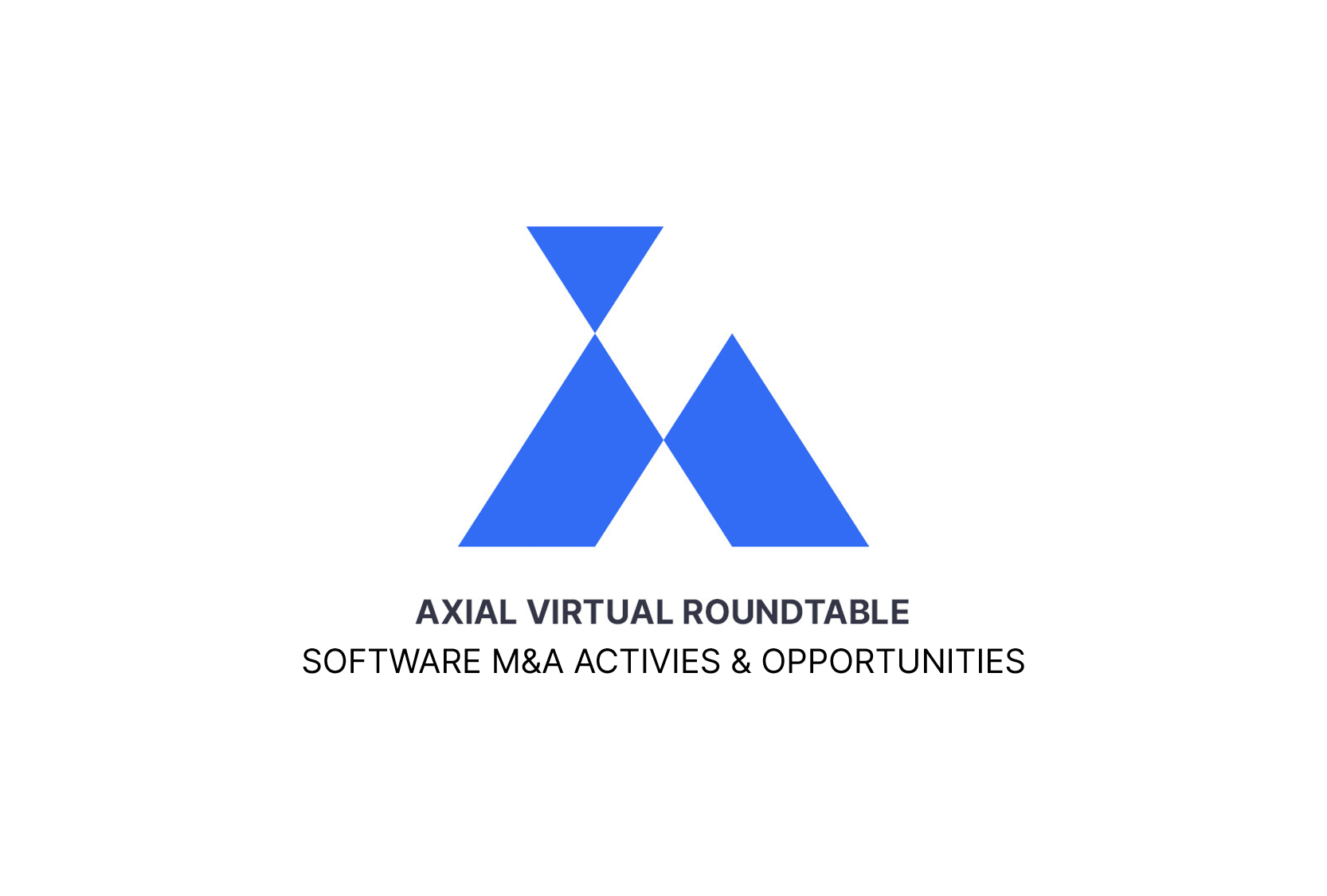In this week’s virtual roundtable, nine Axial members gathered to discuss the current state of M&A in the software and SaaS space. Industry experts from private equity firms, investment banks, and corporations discussed how firms are adapting to the new normal in the lower middle market. Topics of conversation included the recent drop in software valuations, impacts of a newly remote workforce, creative due diligence tactics, and how buyers and sellers are sharing risk to get transactions done.
Thank you to below Axial members who participated in the discussion:
- Nat Burgess, Managing Partner, TechStrat
- Seth Collins, Managing Director, martinwolf
- Frank Dalton, Founding Partner, Fulcrum Equity Partners
- Michael Dufton, Managing Director, Volaris Group Inc.
- Rob Hansen, Partner, Peterson Partners
- Sam Thompson, Senior Managing Director, Progress Partners
- Nik Shah, Co-Founder & Managing Partner, Cohere Capital
- George Shea, Partner, Focus Investment Bankers
- Aaron Solganick, CEO, Solganick & Co.
Video
Audio
Show Notes
Introductions 00:00 – 12:45
Sector-by-sector challenges – 12:45
- Adtech has a lot of exposure to travel & hospitality, so they’re getting hit fairly hard
- There is more optimism this month (May) in the advertising world after April’s hit
- A lot of tech solutions that have exposure need to rework their strategies; i.e. Fandango is losing all of their ticket sales so they purchased Vudu streaming service
- Businesses that touch ecommerce are charging forward with a lot of strength
- Businesses are moving away from brand advertising and moving towards performance platforms
- If a business is cyclical based on a specific segment, that new layer of risk is forcing companies to adapt and grow
- Healthcare IT vendors that are trying to sell into this ecosystem are being pummeled because healthcare businesses don’t have the time to focus on talking to new vendors and oftentimes aren’t going to use limited budget to renew SaaS subscriptions
- However, telehealth is facing an uptick because it’s been one of the only ways that medical practices to stay alive
- Valuations shot up significantly for software players that are in the telehealth space
- Companies with a telehealth arm had to pivot and focus on that part of their business, which was in such demand
Working remotely + the new normal – 30:00
- A lot of the trends that we’re seeing have been accelerated greatly by the pandemic, but that does not necessarily mean that they’re not sustainable
- A business in the corporate training space is pivoting to focus more on remote workforces, but an increase in remote work is something that is likely here to stay
- A lot of healthcare and edtech fall into the same category, where there are “short-term” boosts that will actually end up being sustainable
- All of these technology offerings are going to continue to improve, which will in turn further solidify their place in the ecosystem
- While remote work works very well for some industries, there are others that are not going to be able to continue on a (fully) remote path (i.e: in M&A, diligence is never going to be done completely digitally)
The importance of being “mission critical” – 35:50
- In software, you’re broken into two categories: products that are mission critical, and those that are not
- The idea of being “mission critical” is so important, because it eliminates a significant amount of the risk that would normally come with selling into troubled sectors
- If a company is selling into the retail and transportation spaces — both very heard hit in this crisis — but the product is a need-to-have, as long as the customer is in business, they will continue to pay
- These companies may still see some impact in their growth numbers, but they are secure when it comes to their renewing revenue
- There is a whole world of smaller software businesses that provide products and services that are bucking up infrastructure for remote work
- Sometimes it’s businesses that are being harder hit that are reaching out to see what solutions are out there to help them recover
- When budgets are getting cut on a monthly cadence “nice to haves” are the first to go
- The must-have/nice-to-have idea carries over into M&A — a lot of the deals that are getting done are add-on transactions that are allowing businesses to stay alive
How the debt market is impacting how deals get done – 40:30
- There is so much dry powder, so after the second quarter, there has to be a rebound
- Debt is more expensive, which is going to impact valuation
- There will likely be more equity checks
- Leverage has already started to come down and it will continue
- There is a world of private credit funds today that were not around in 2008, so while debt is more expensive, the money is there
- And since private credit funds are paid out similarly to PE, they need to do deals
- LPs typically don’t care how the GP levers a deal, they’re relying on the PE firm to make the right decision
- For software businesses in particular, the credit market will likely come back quickly
- In a lot of other industries, lenders need to go on site to do diligence work; in the software space, you can inspect code
- The array of diligence blockers for software deals is lower than in other sectors
- That said, not being able to meet a management team is a big issue that will halt a deal
- There are earlier-stage seed deals getting done without any in-person diligence
- You can artificially try to create a social environment via Zoom, where you’re not just talking business but getting to know each other more personally
- If everything else in a transaction lines up, certain deals can be completed without having met a management team in person
- Investors that buy software businesses are more likely to be used to people working remote, so this may help with M&A in the industry
When will in-person meetings start back up? – 48:50
- Peterson Partners just received their first request to meet with a management team in person, which would require a short flight
- Geography is becoming increasingly important when firms are looking at deals
- Some people are comfortable traveling right now, and others are not
- Spouses or family members are now a much more realistic roadblock to deals getting done if they’re not comfortable with travel and/or in-person visits
Creativity to increase the likelihood to close – 53:56
- It is the responsibility of bankers to get creative around how they can make it easier to get to know a management team
- For many business owners, it’s not possible to sell right now anyway; however, they should use this time to build relationships so that by the fall, they’ve laid good groundwork
- Inverting the process: there is a lot of diligence work that can be done remotely that may have previously been done later in the process, but a lot of firms are now doing all of the digital work up front. Then if the only thing that is left is meeting, you’ll be ready to get the deal done once that happens
- There is a lot of relationship building going on right now virtually
- You can do more financial diligence while you’re in a non-exclusive position; you would likely wait to do a lot of the legal diligence until you’re under exclusivity
- For intermediaries, they not only need to build relationships for specific transactions, but they also need to continue to build relationships with potential clients
Structuring a transaction & sharing risk – 1:01:01
- When COVID hit, TechStrat was about to close with one of their clients, and after reevaluating the financials, etc. they ended up with the same deal, but 30% of the consideration was deferred, and the timeline to hit that original plan was extended 6 months
- Traditionally an earnout was about a business hitting an “unrealistic” forecast, but right now it is more about everyone being uncertain and sharing risk
- Most businesses have reduced their forecasts significantly
- Hold-back escrows are key for buyers right now (they’re happening more often and a higher percentage — where it would often be 10%, now it may be 20%)
- One way to bridging the gap is by making an earnout come over a shorter time period
- Rather than earnouts, seller notes, etc. what seems to be happening more often is that parties are just delaying
- If either a buyer or a seller is not open to sharing risk, a deal won’t get done
Valuations – 1:07:00
- Valuations are coming down
- Healthcare IT client was asking for 12x EBITDA and now they’re asking for 9-10x
- In software where it used to be 4-6x it is now 2-3x
- A lot of businesses were overpriced when the economy was booming, so if they think they should be valued at the same thing now, they’ll receive a lot of pushback
- Even if a deal isn’t hugely different in the valuation, that is where transaction structure will come into play (In January a client of Martinwolf was expecting 10x EBITDA, they just got an offer at 9.5x; but instead of having 80% cash at close, it has shifted to 60-65% cash at close)
- For a strategic acquirer who is buying 100% of a company upfront, they don’t have the flexibility to adjust the cash at close

